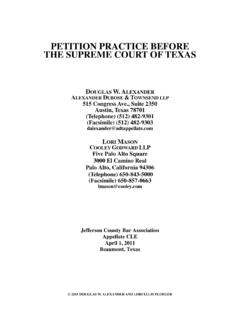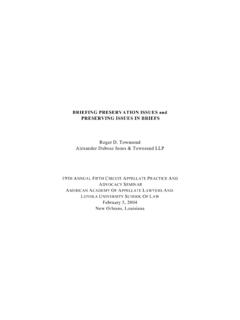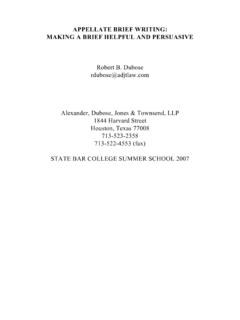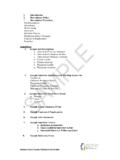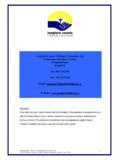Transcription of S:WebsitePublicationsHow to Write a Good …
1 WRITING A. good SUPREME COURT. BRIEF ON THE MERITS. Kevin Dubose Alexander Dubose Jones & Townsend llp 1844 Harvard Street Houston, Texas 77008. (Telephone) (713) 523-2358. (Facsimile) (713) 522-4553. TEXAS BAR CLE. PRACTICE BEFORE THE TEXAS SUPREME COURT 2004. April 16, 2004. Austin, Texas Writing a good Supreme Court Brief on the Merits Chapter 6. TABLE OF CONTENTS. Page INTRODUCTION .. 1. I. Mechanics and Components of a Supreme Court Brief on the Merits .. 1. A. Mechanics and Formatting .. 1. 1. Margins and spacing .. 1. 2. Font size .. 1. 3. Record Citations .. 1. 4. Footnotes .. 1. 5. Page limitations .. 1. B. Components of a Brief on the Merits .. 2. 1. The Cover .. 2. 2. Identity of Parties and Counsel.
2 2. 3. Table of Contents .. 2. 4. Index of Authorities .. 2. 5. Statement of the Case .. 2. 6. Statement of Jurisdiction .. 3. 7. Issues Presented .. 4. 8. Statement of Facts .. 4. 9. Summary of the Argument .. 5. 10. Argument .. 5. 11. Prayer .. 5. 12. Signature .. 5. 13. Certificate of Service .. 5. 14. Appendix .. 6. II. Giving Your Audience What It Needs: A Strategy That Enhances Your Chances .. 6. A. Identifying your audience .. 6. B. Identifying your purpose .. 7. C. Understanding your audience's working conditions and mindset .. 8. D. Give Your Audience What It Needs .. 8. 1. Assist the Court in doing its job .. 8. 2. Assist the Court in doing its job justly .. 9. 3. Assist the Court in doing its job efficiently.
3 10. 4. Assist the Court in doing its job in a manner that it may find persuasive .. 10. III. A Technique for Building the Perfect Beast .. 11. A. Re-analyze the issues .. 11. B. Review the substantive law .. 11. C. Thoroughly read the Clerk's Record and Reporter's Record .. 11. D. Do more legal research .. 11. E. Prepare a detailed outline .. 12. F. Integrate the record notes and research notes into the outline .. 12. G. Write a prose version of the outline .. 12. H. Set aside this first draft for several days .. 12. I. Return to the first draft and edit it ruthlessly .. 12. J. Get other people to read the next draft .. 12. L. Have someone other than the writer check every legal citation and record reference in the brief for accuracy.
4 12. M. File a perfect brief .. 13. IV. Acknowledgments .. 13. APPENDIX. Sample of Petitioner's Brief on the Merits Writing a good Supreme Court Brief on the Merits Chapter 6. WRITING A good SUPREME COURT In recognition of the declining vision of most appellate justices, the Fifth Circuit requires 14-point font. Readers BRIEF ON THE MERITS accustomed to having to reach for reading glasses and that includes most justices will appreciate 14-point font. Introduction If you have room, I recommend it. My assignment was to Write a paper called How To Write A good Supreme Court Brief. That title implies 3. Record Citations that there is a simple technique or formula that can be The 1997 appellate rule changes eliminated the applied to every case so that a good supreme court brief long-standing (but somewhat confusing) labels pops out.
5 Nothing could be further from the truth. What transcript and statement of facts in favor of the more makes a good supreme court brief in any given case turns straightforward and descriptive clerk's record and on so many variables underlying facts, applicable reporter's record. TEX. R. APP. P. , The substantive law, type of litigants, personalities and abbreviations CR for clerk's record and RR for reputation of counsel, nature of the court of appeals' reporter's record are recommended. Volume and page disposition, to name a few that there is no universally number citations to the reporter's record are sufficient, applicable method for writing a good supreme court , RR 3:181-82" or 3 RR 181-82.
6 (Line numbers brief. are not required, and only add unnecessary length.) If the However, there are some basic guidelines you record is complicated (for example, if there are should follow to both comply with the appellate rules and supplemental volumes of the clerk's record or transcribed demonstrate minimal competence to the Court. There are hearings in the reporter's record that fall outside the some strategies that should guide your writing so that it consecutively numbered volumes of the reporter's record is more likely to assist the court in reaching a result that from the trial), consider including an explanatory is both beneficial to the jurisprudence of the state and sentence or two at the beginning of the brief.
7 Favorable to your client. And there are some writing techniques that I can suggest for assembling all of this 4. Footnotes information into a comprehensive and comprehendable Limit the use of footnotes as much as possible. product. Many Justices admit that they do not always read them. Although my topic was broadly labeled as supreme If you have something that you want to be sure the court briefs, another speaker/author for this course, Justices will read, put it in the text. If you do not care Doug Alexander, is doing his usual outstanding job of whether it is read, you should consider omitting it separately addressing petitions for review. Accordingly, entirely. If footnotes are necessary, they may be this paper will focus solely on briefs on the merits.
8 Single-spaced. TEX. R. APP. P. (d). Although the rules allow the use of 10-point font, at least 12-point font I. Mechanics and Components of a Supreme Court is recommended. Brief on the Merits Before learning to run you must learn to walk, and 5. Page limitations before learning to walk you must learn how to crawl. Briefs on the merits are limited to 50 pages, Similarly, before entertaining important strategic exclusive of the following sections: identity of parties considerations concerning writing style and analytical and counsel, table of contents, index of authorities, approaches, brief preparation must start with an statement of the case, statement of jurisdiction, issues awareness of how a brief should look and what must be presented, signature, certificate of service, and appendix.
9 Included in it. TEX. R. APP. P. As Justices are always quick to point out, this page limit is a ceiling, not a floor. They do A. Mechanics and Formatting not think less of you or your position if you file a brief on 1. Margins and spacing the merits that is less than 50 pages. In fact, as you might The brief must have at least one-inch margins (top, understand if you were reading through a stack of briefs bottom, and sides). TEX. R. APP. P. (c). Although the on the merits, shorter briefs are usually greatly text of the brief must be double-spaced, block appreciated. quotations, short lists, and issues or points of error may be single-spaced. TEX. R. APP. P. (d). 2. Font size The rule regarding font size looks complicated, but it boils down to this: unless you use a manual typewriter, use 13-point type or larger.
10 See TEX. R. APP. P. (e). 1. Writing a good Supreme Court Brief on the Merits Chapter 6. B. Components of a Brief on the Merits they are interested rather than wasting time flipping 1. The Cover through pages looking for their destination. Anything The cover should be clean and simple. The required you can do to make it easier for the Justices to use your cover contents are the case style; the cause number; the brief when writing their opinion is an obvious advantage. title of the document being filed ( Petitioner's Brief on The rules also require that the table of contents the Merits or, if there are multiple parties filing separate indicate the subject matter of each issue or point, or briefs on your side, Brief on the Merits of Respondent group of issues or points.)

